Video
tumblr
This is Misato Yamaha, the teenage girl on the cusp of young adulthood. She was created by her father for the Yamaha Corporation. Her function was to be an air raider. As she reached the age of adulthood, she had started to build herself and design her own weaponry. She elected to not tell her father that she was going from Misato to Mega-Misato. Coming to terms with this great schism, she had told herself “I’ll never forget this complicated emotion”.
2 notes
·
View notes
Text
Sonehati
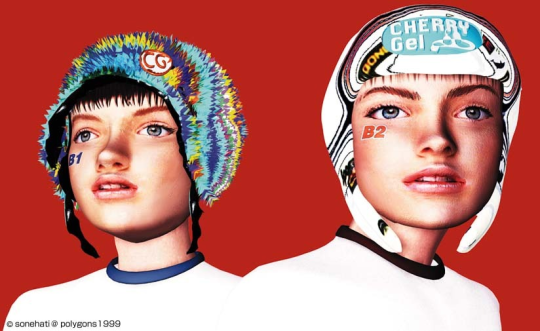
Bio Twins
The truth is that I could write an entire dissertation on Sonehati. I know so much information on him that it has been somewhat difficult to discern what specific element of his work is the most important to me. In the end, I have chosen to discuss his most notable work, the Polygons Album, Sonehati CG Works 1999. This album is a large compilation of Sonehati’s work. Specifically, it contains his preliminary character design renders, stories, and completed compositions. There are even movies, and each of the images featured in the album are already pre-scanned on a CD. This album is likely to be considered his magnum opus, not merely based on the comprehensive and exhaustive curation of his work, but also because it greatly reflects his character design ethos and aesthetic during his prime.
Sonehati is a graphic designer and CG artist. He started to work as a designer in the early 90’s after having gotten a degree in oil painting from Tama Arts University. In 1995, he started up a studio titled “Polygons”, where he and his associates worked to create “computer-generated cute girls” (Virtual Beauties 2020, 148). Some of these characters would go onto be apart of movies and some went onto become apart of games. Polygons is a reference to the fact that digital rendering software contains polygons from which the figure is formed. Sonehati’s specific software is NewTek Lightwave 3D, which I find is somewhat common among 3D artists in Asia. In places like the US, most 3D artists use Blender, Cinema 4D, Modo, or a combination of the three. The use of Adobe PhotoShop is also an almost inherent component of the digital rendering toolkit, and Sonehati does use that too.
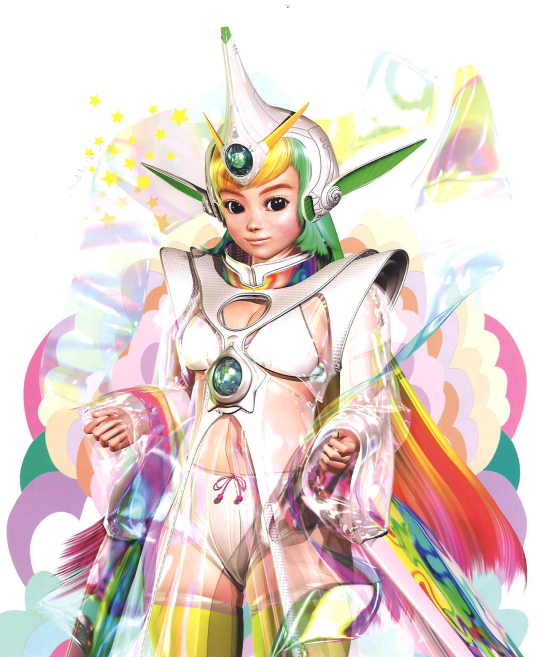
Virtual Beauties 2020, pg 173
Beyond being the name for his studio, “Polygons” is also the same of a self-created race of beings emerging from the virtual world as cybernetic life. Sonehati believed that these virtual characters were more suited for the internet as opposed to mere illustrations or pre-rendered movies (148). From the internet their stories would begin. It’s fitting then, that these “Polygon people” are the focus of the Polygons Album.
There is a thorough cast of figures Sonehati has designed, more than I could ever hope to touch on in this entry. I have elected instead to focus on the characters that I personally find to be the most interesting and most appealing, and who happen to be more famous than the others. Something to keep in mind about these characters though, is that regardless of their differences in identity, they are all made out of polygon skin, are usually quite racially ambiguous (Japanese, Jewish, German, and potentially Italian to be specific), and are incredibly futuristic. I believe that Yukari of the Copyright Guild is the best first example of this.
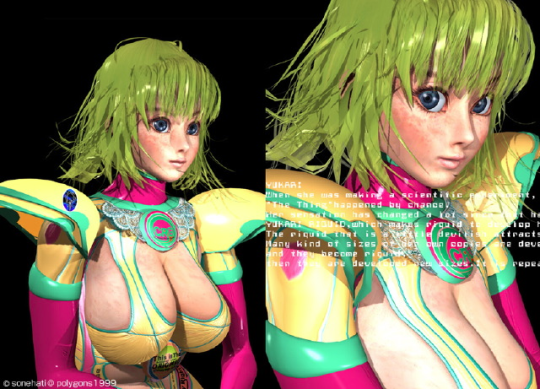
Yukari: When she was making a scientific experiment, “The Thing” happened by chance. Her sensation has changed a lot since that happened.
Scientist Yukari becomes a victim of a freak accident of her own making. “The Thing” is soon revealed by a riquid (render + liquid = riquid), which takes her name (Yukari Riquid), and that continues to make many forms of herself.
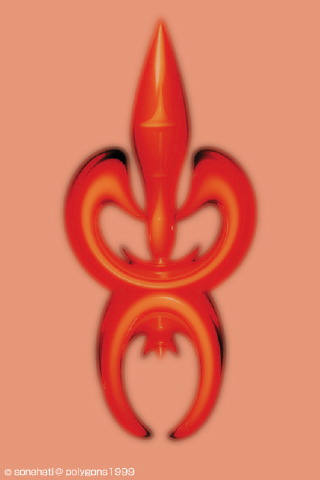
Yukari Riquid, which makes riquid to develop her own copies. The riquid that is a little devilish attracts Yukari. Many kind of sizes of her own copies are developed, and they become riquid, then they are developed new sizes. It is repeated.
Truthfully, Yukari has no control over the riquid and its constant replication of herself. But she makes the best of it, eventually forming the Copyright Guild (CRG). She, as the original, is the leader. Together they aim to save the world. “To the Man; to the Earth; to the Right...”
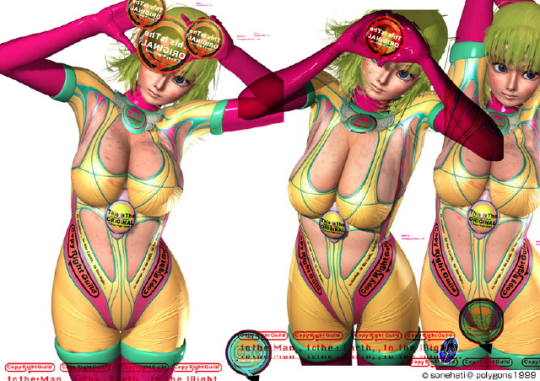
Ichijouji Yukari
Some of the Yukari, such as Hyper Yko., appear to do their own thing and become the most popular of the CRG. Hyper Yko. is so popular that the alternative title for this album is Yko Hyper Album. Some pages of her own notebook are spliced in.
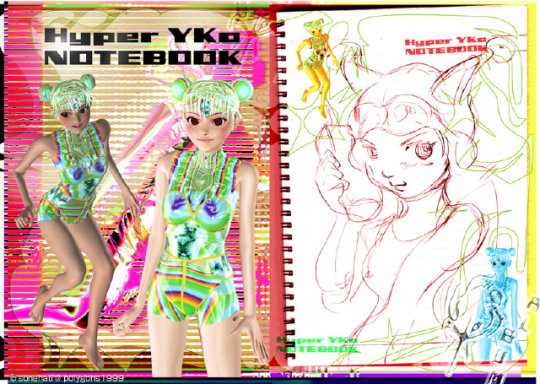
Hyper Yko Notebook
There are so many more characters that I would to discuss, but I will end with the reference of BeamMan, Sonehati’s award-winning character.
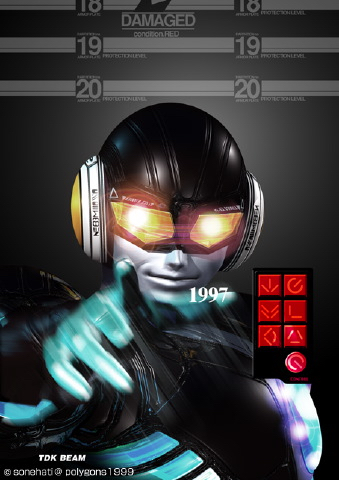
TDK Beam; 1997
I say that BeamMan is award-winning because he appeared on the package design that won Sonehati a prize in London in 1997.
There is something about BeamMan that might draw people to him. On the surface, he seems to be the antagonist the other characters are hoping to defeat.

88880087 (BeamMan)
But then he cries while looking up at the night sky.
In the end, Sonehati’s work explores in great depth the refuge and freedom his characters desire. There are women scientists force to reckon with their sense of identity (Yukari), a teenage girl who doesn’t know her own power (Sayaka 17), and then another that is too afraid to tell her dad that she has claimed hers (Misato Yamaha and then Mega-Misato). They put on power suits and go to battle with an enigmatic force, which is ultimately the Devil Riquid who attaches itself to young girls and women with power. Nearly all of these characters are implanted with Sonehati’s own identity, whether it’s his attraction to women with larger breasts, his affinity for music, and finding his own sense of self on the cusp of the new millenia as a new designer.
Like I said, there is so much more to this book that I could write a book of my own about it. I am very lucky to have obtained the greatest book I have ever owned in my life, in such great condition. It came with the original CD with the scanned images, movies, and even files on how to create the characters yourself using the Lightwave software. This book turned 20 years old in January and I am 21 since February. I believe that the greatest depth to this book outside the self-discovery of young girls and women is that is a relic of its time. In that people my age and even younger were expected to inherit a new and better world at the turn of the century. Obviously this never happened. In seeing young girls and young women fighting the same late adolescent, early adulthood fight, but playing drums during it all or maybe building a better body to fly in, I wonder what would have happened for young people this day if this world wasn’t plunged into chaos in 2001.
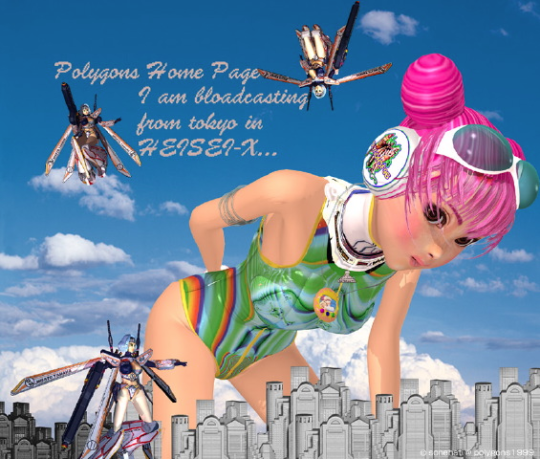
Hyper Yko broadcasting from Heisei-X is the most ghostly image of them all. In 1999, the incoming Heisei era was considered a good thing. Now it is known as the “Lost Era”, and Japan is just now getting out of it. Again, I wonder what would have happened for young people of now if the positive predictions of our futures came to fruition.
I plan to write a total analysis of the Polygon Album one day very soon. Until then, as Sonehati would say, “Love and Pixels”. I had a great time writing on this blog and I learned a lot. Thank you!
Works Cited
Sonehati. Polygons Album: Sonehati CG Works 1999. IDG Communications, 1999.
“Virtual Beauties 2020.” Virtual Beauties 2020, Agosto, 2002, pp. 148–173.
87 notes
·
View notes
Text
Hung Tung-Lu; Y2K Cult Icon

Hung Tung-Lu
Hung Tung-Lu is a Taiwanese artist with a great vision and great use of his talent to create art that meshed well with the era of which he was apart of. What I want to write most about in terms of Hung is that he focuses on pop culture icons, digital avatars, and themes of religion mixed with science. This seems to be a lot, but ultimately it’s about explaining how progressive his thought process was, and how despite his invisibility, this is how he became a cult icon of the Y2K era of art and design.
The very roots of Hung’s ethos is rooted in his desire to manifest “new”. He is working in an era where everything is rapidly changing, specifically young Taiwanese people are being able to interact with the world at large via the consumerism facilitated by Taiwan’s industrialization and globalization. Therefore, Japanese media experiences an influx, the internet takes off and changes the face of human interaction and sense of identity, and also the new kids are shopping with the desire of reaching some sort of emotional nirvana within themselves. This is all immediately evident in his work.
I would like to further say that beyond this representation in his work, one pretty prominent element of Hung’s work or aesthetic is how it further reflects this attitude of progressivism. He graduated in 1999 with degrees in painting and the plastic arts. Thus, much of his work is in bronze, porcelain, ceramic sculpture. However, in reference to the zeitgeist of which he lived, he pushed beyond the barriers of painting and sculpture and also worked in photography, produced lenticular or chromogenic prints, and his sculptures became 3D, digital “renders” instead, with his most prominent character, his avatar Xiao Hung, occupying both a more traditional sculptural form and also a digital avatar form as well.
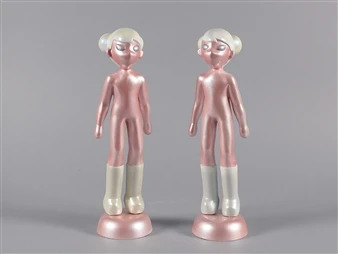
Na-Cha (2003)

The Birth of Xiao Hung (2002-2006)
I believe that his original characters such as Xiao Hung, his interpretation of Asura (an Indian deity in constant battle with supernatural forces), and his little girl androids, are the most compelling element of his work beyond his representation of the female anime characters he also features, such as Rei Ayanami from Neon Genesis Evangelion. They possess very detailed and well-fleshed out stories, especially when it comes to Xiao Hung. Xiao Hung is commonly believed to be a little girl, but as the artist explained, Xiao is “a virtual neutral character, no gender, and no age. I was not a child.” (Meng Mengzhen) This character is undoubtedly a reference to Hung’s own desire to manifest the new in a different form, which is why they share the same family name of “Hung”. Xiao is a genetically engineered clone who also has become an alien bounty hunter and a young god. To me, the character is also a more abstracted Hung Tung-Lu, as already established by the artist himself.
More specifically, it is known that Hung Tung-Lu is a true internationalist. He is someone who has moved around a lot and worked in different cities and countries, and has also been personally exposed to international tragedies, such as 9/11. Therefore, Xiao Hung and even Asura’s adventures through space and New York and their violent confrontation with invaders or aliens could be considered more fantastical retellings of Hung Tung-Lu’s own life experiences. Further, Xiao being a clone that has been destroyed but also reborn many, many of times with many iterations of herself taking on new identities and purposes, she can be a representation of the Taiwanese Youth’s regular transformation via consumerism. Further, her physically reaching nirvana with her body occupying and spawning divine elements, she can also be a metaphor for this nirvana-like state achieved via the obtainment of a consumer object. Also, of course, she is Hung Tung-Lu’s new persona, who is more reflective of the state of popular iconography of the time (Asian, anime girls).

Ayanami Rei (1999)
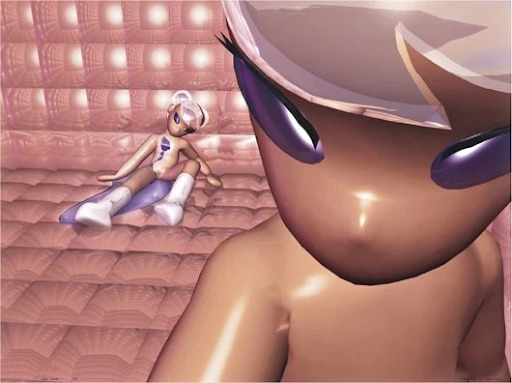
Cyber Murder 1 (2002-2006)

Bounty Hunter No. 1 (2002-2006)

Svara (2002)
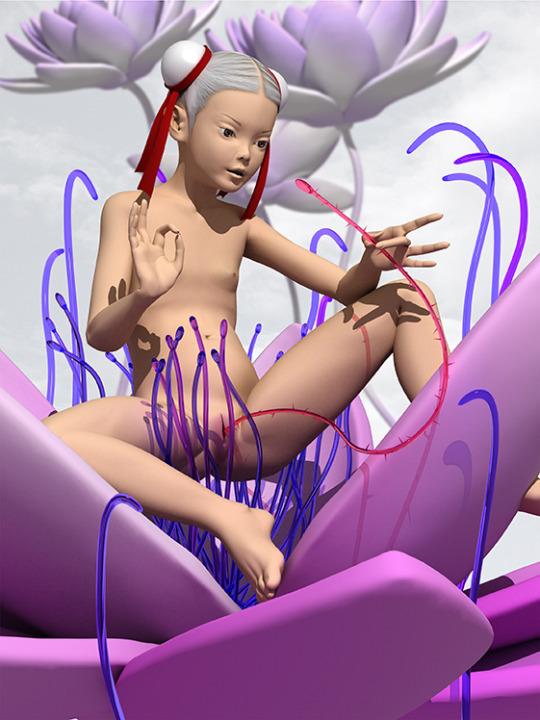
Here... (2002)
I would say that, ultimately, there are many layers to the ethos and aesthetic of mixed media artist Hung Tung-Lu. His work is riddled with progressions in the forms of art he studied, with painting becoming photography and prints, sculpture becoming digital renders, and also his work riddled with metaphors laced with detailed narratives. I believe that he might be one of the artists that best manifested the zeitgeist in which he worked within. Consumerism, the Internet, and their effects on the contemporary human experience is quite relevant to us all in light of existing in the late-stage capitalism era. Usually hyper-consumerism is represented in purely and obviously negative light, but that is not the case with Hung’s work. He reflects the innermost state or desire of the young consumer, which is their desire to reach an emotional state of euphoria and to live within a utopia that reflects the beauty that anime, video games, and shopping can offer. But that does not mean that there is no conflict. Xiao Hung dies multiple times, and teen girl Asura must fight alien conquerors in New York City. But yet, she fights on roller skates and with a Super Soaker.
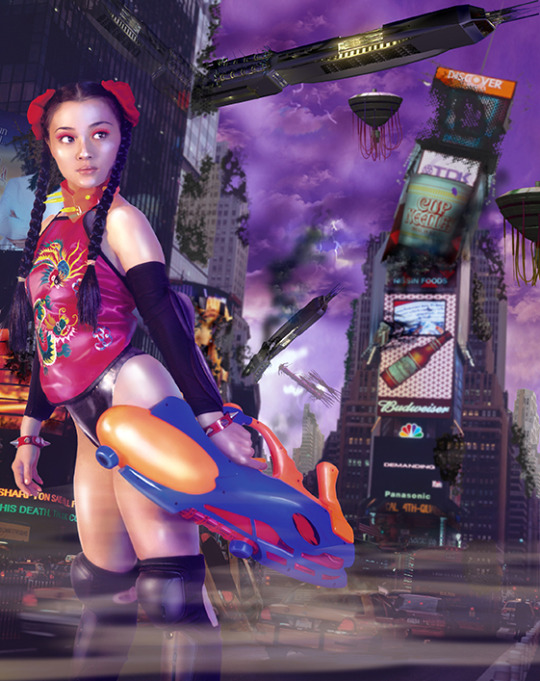
Asura - Time Square (2001-2006)
In these kind of moments, I would almost think that perhaps, Hung Tung-Lu is a true artistic genius. To represent so plainly and recognizably the naivete of the consumer who believes that they can fight to survive the obvious dystopia of this world armed with objects of joy and entertainment such as a Super Soaker (a common toy of the 90’s and 2000’s), I can see why, despite his invisibility as an artistic figure, Hung Tung-Lu is a cult icon of the Y2K era of art and design.
I say that Hung is invisible because there are but a few images of him on the Internet, his personal website is not functional (at least not on my computer), and nobody knows where he really resides. He could be in Shanghai, Taipei, or NYC, and we wouldn’t really know because he’s so quiet (with much to do with the oppression of artists in Taiwan). I did manage to find a video of him during a presentation on Absolut Vodka’s relationship with the fine arts since Andy Warhol (Hung Tung-Lu became one of the first Asian artists to collaborate with a popular spirits brand, which is why he was present). But it was a very short glimpse of him. The fact that Hung Tung-Lu is such an enigma, but yet somewhat influential with a legacy of really pushing boundaries, is likely one of the main other reasons why I consider him to be one of my favorite artists.
youtube
Absolut Art Collection (2009)
He and Sonehati, who I will discuss in my last entry, are idols to me because of the fact that they render and I am working very hard to get on their level. And so in seeing their work, such as the many adventures of Xiao Hung, I am greatly motivated by them, and why I chose them as my two last artists to spotlight on my blog. I am hoping that more people can know about them and appreciate them as much as I do in reflecting on their work with great detail.
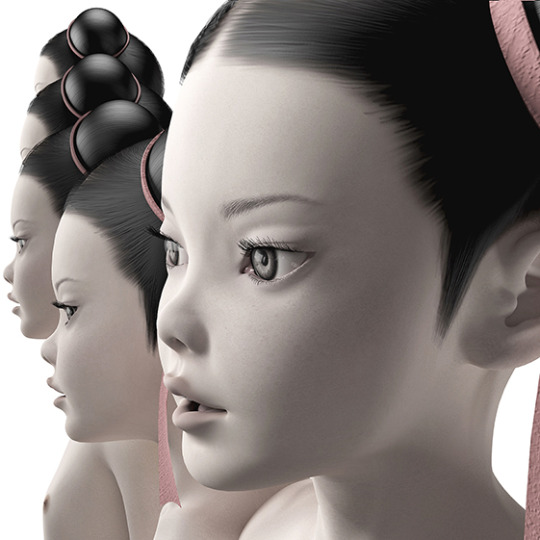
Android (2008)
Links:
http://www.itpark.com.tw/artist/statement/27/98
https://www.linlingallery.com/eng/artists-d.php?id=18
https://entoolkit.culture.tw/artinfo_107_830.html
https://chiwengallery.com/artists/hung-tung-lu/biography/
https://ravenel.com/cata/lotsIn/1469247d-b7df-4a92-81ef-0fe7767421c8
http://knihomola.blogspot.com/2011/04/absolut-vodka-30.html
https://www.youtube.com/watch?v=EnvExxRDAp0&t=149s
9 notes
·
View notes
Text
Mariko Mori: Women and Identity

Mariko Mori is a very fascinating conceptual artist to me, and among my favorite artists of contemporary art. She is an artist that represents the perfect fusion of science and spirituality with the arts and design, drawing from her background to create compelling art work. Much of this said work contains themes of feminism and the desire to find an identity, and involves photography, sculpture, architecture, and fashion design, just to name a few forms. I am most impressed by how Mori expresses these thoughts and how she creates narratives in her work. Seeing things like cyborg women or girls in an arcade remind me of the kind of things I was surrounded by as a child and that I loved so much growing up, and I feel that because of the familiarity of these characters and scenes I can relate to her work the most.
Mariko Mori has been interested in fashion (like myself) since she was a young child. As a teenager she became a fashion model and then as a young adult she studied at Bunka Fashion College Tokyo. Though fashion may have been her greatest outlet and perhaps her first love, in Bunka she found herself restricted by the scope of fashion saying “...it always has to produce the clothes. Actually, it’s a consumer product. So, after that I changed my direction.” (Jessica Holmes) After her graduation from fashion school, she had decided to go to an art school outside of Japan. At Chelsea College of Art in London, she had begun studying painting, and then by year two she had already began to branch out. Coming from a home where “interdisciplinary” was the norm, Mori had always desired a space in which she could truly reflect the breadth of her knowledge and thoughts. Having a father as a professor of economics, scientist, engineer, and inventor and an art historian as a mother is what has allowed for Mariko Mori to understand how the sciences and arts can interact harmoniously. Having an interest in Japanese spirituality at nine years and always being a fashion kid, you can also see this element of herself manifest in her photographs and videos.
Travelling to the West (she did eventually go to New York as well to study in Whitney Museum of American Art's Independent Study Program), she was awakened to the sort of roles women occupied in comparison to home. She reflected, “So really, I was quite shocked by a lot of the professional women in London who were doing something—changing the world. Powerful, confident, and very influential. I was very inspired by that, and also that in the arts in London there was so much freedom, no limitation.” (Jessica Holmes) In five years time, she was ready to return to Japan and use her newfound power and vision to make a social critique.
Mori used her experience with fashion and modelling to create out-worldly characters that functioned as social disruptions and as avatars for Japanese women’s experiences of invisibility in men’s spaces. In both Subway (1994) and Play with Me (1994), she had taken on the character of a cyborg.
Subway (1994)

In Subway, she had worn a silver armor and appeared on the subway as normal. You would think that her appearance alone would garner some level of attention, but judging by the picture, no one cared.
Play with Me (1994)

In Play with Me, she had become a blue cyborg heroine with more elaborate dress, but again she had simply faded into the background of the video shop and the men just casually passed her by.
Warrior (1994)

She had appeared in the arcade as well as a video game warrior dressed in a survival suit. This performance was titled Warrior (1994), and again displays an apathetic crowd of boys unknowing or uncaring of her existence. Perhaps the most damning piece of evidence of how little visibility women have in male spaces is her Tea Ceremony series.
Tea Ceremony III (1995)

The significance of how invisible women are easily rendered is that this ease of erasure makes it difficult for women to gain respect. Mariko describes herself as growing up in era where the woman's role was not so defined, and then her mother had lamented the lack of equality in her field. “Also when I was growing up, the woman’s position wasn’t so defined as now. My mother is an art historian, and I remember she used to complain about things not being equal.” (Holmes) Mori’s mother was also the only female professor in the university she taught at, and so it can be assumed that her mother experienced even more heightened inequality because of how easy it may have been for her peers to just not see her.
Often when discussing women’s unequal treatment in the workplace, whether its abuse or lay of pay raise, it is suggested that the woman do her best to become more assertive and more visible. But here we seen an artist assert herself greatly multiple times, becoming a cyborg heroine of many kinds and then a video game character as well, and she is still not noticed. This is why I believe that Mariko Mori’s work has great significance in expressing the experiences of women, and their place and identity in our patriarchal culture.
Links:
http://www.artnet.com/artists/mariko-mori/
https://www.guggenheim.org/artwork/artist/mariko-mori
http://www.dreamideamachine.com/en/?p=2070
http://www.marthagarzon.com/contemporary_art/2011/08/mariko-mori-cybergeishas-technonolgy/
https://www.nytimes.com/2006/08/27/style/tmagazine/t_w_1593_1594_well_mori_.html
https://www.moma.org/learn/moma_learning/mariko-mori-star-doll-for-parkett-no-54-1998/
http://intersections.anu.edu.au/issue23/holland.htm
https://brooklynrail.org/2018/04/art/MARIKO-MORI-with-Jessica-Holmes
7 notes
·
View notes
Text
Damien Hirst on Death

Death has always been an enigmatic subject to me, as I could never truly wrap my head around the phenomenon. Its existentialist qualities are likely the reason why I find a special affinity for the work of Young British Art (YBA) Damien Hirst. His artwork, which includes large scale bronze sculptures, tanks full of formaldehyde and animal carcasses, and screen prints on paper, creatively explores the emotional and intellectual impact of death, from grief to its physical unfathomability. These works are confrontational in how they challenge us on our expectations about death and whether or not we are ready for the truth of it to be revealed to us, which is its unavoidability.
Pharmacy (1992); Tate Museum

Up until early 2018, I was apart of circles and subcultures with ties to a philosophical concept called “Transhumanism”. Transhumanism, on its most basic level, requires the leveraging of science and technology to assist the human being in transcending their basic form. This transcendence could involve the evolution beyond all barriers from gender to material form to baseline abilities, but popularly it is about the achievement of immortality by 2045 thanks to the progression of medicine. Utopian Pharmacology, a term coined by David Pearce in The Hedonistic Imperative (1995), is a hallmark of Transhumanism, and a hallmark of the fight for immortality.
Despite the efforts going into utopian pharmacology, I cannot help but see the fight for immortality as a fruitless goal ultimately rooted in the fear of dying. Damien Hirst’s Pharmacy (1992) is something I like to reference as an early criticism of the concept. In the Pharmacy, a person is allowed free rein over the pills they select. Specifically, a person is allowed control over their health and immortality, as this is what these pills are for. They do not have to answer to a gatekeeping pharmacist that would restrict their access to the pills, and perhaps in the end they will not have to answer to the Grim Reaper either. However, Hirst’s Pharmacy is not a safe haven from an inevitable end, as he does not believe that science or modern medicine can prevent death. I see this pharmacy as a physical allegory. The person is allowed to mull around and select whatever they are certain will prevent a certain death, allowing a sense of empowerment that is soon taken away. Though the pharmacist is not visible, they still exist in this place. The illusion of the Pharmacy is soon shattered.
The Last Supper: Corned Beef (1999)

Another criticism of utopian pharmacology I have found of Hirst’s is his The Last Supper (1999) series. In The Last Supper, Hirst had designed screen prints that mimicked the packaging of pills, and had labelled them with the names of common foods, which include corned beef, salad, sandwiches, and more. Again, we see the potential attempts of someone to use medicine to cheat death. Here food is reduced to its barest form, which is sustenance to provide the body enough energy to keep going. There is no true material experience with nourishment. Normally meals are used to facilitate social interaction among others. Being used merely as a way to escape death, perhaps in trying to transcend core elements of the human experience, which is death, people may transcend a sense of humanity altogether. Again, the illusion of having found a medical solution to the disease of human mortality is easily shattered. The Last Supper references both Damien Hirst’s Catholic education (with him regularly incorporating Catholic symbols, tales, or parables into his work) and of course the death Jesus after The Last Supper. It also references again the inevitably of death. These pills could sustain the body and their medicalized appearance lends even more to their illusionary potential. However, the person who takes them will still die. One of these pills will be their last supper.
The Physical Impossibility of Death in the Mind of the Living (1991)

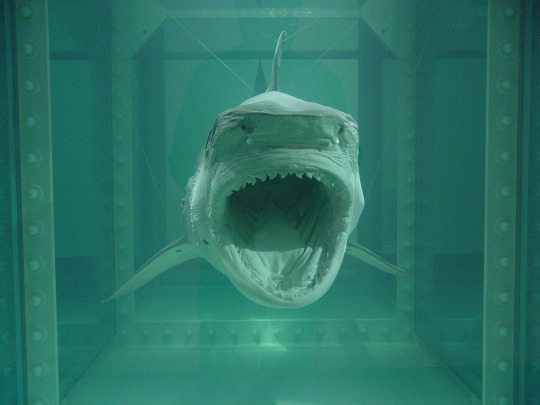
Most people find mortality to be too strong of a force to reckon with, whether it is on an intellectual or emotional level. Damien Hirst offers the viewer a chance to confront it nonetheless. The Physical Impossibility of Death in the Mind of the Living (1991) is a sculpture that involves the carcass of a tiger shark suspended in formaldehyde in a tank. It has a distinctive power within it, with the tiger shark seemingly being alive but very much deceased. From all angles of the tank, we can formally recognize that in any other circumstances in which the shark was living, we would be in mortal danger. But here we are not. And so the sensation of danger, the adrenaline and the fear, it all subsides. With those physical ailments out of the way, we are now viewing death from a nearly objective, intellectual perspective. We can understand that the shark is dead and that its animated state is an illusion. Our death is an impossibility to us in this moment as the shark is not alive. This realization is an important aspect of this experience as implied by the title of the work, as even as we process mortality, our own and the mortality of other living beings, we are not experiencing death. Not only are we not dead by a shark bite, but because we are alive, the physical experience of death is beyond us. And it always will be as the living cannot intellectually or physically experience death, as “dead” and “alive” are two fundamentally different modes of existence that are irreconcilable.
Mother and Child (Divided) (1993)

Despite death being an impossibility in the mind (and body) of the living, I have heard many people in my life say of themselves that they have “experienced the death of a loved of one”. I ask myself how that could be so when they are still standing and inhaling oxygen on this earth; the truth is they have experienced grief, a natural consequence of death in the mind of the living. Damien Hirst has works that explore this element of the mortal experience. A great example would be Mother and Child (Divided) (1993). This sculpture follows the same formula as The Physical Impossibility…, with the carcasses of slaughtered animals being suspended in formaldehyde in a tank. They are mother cow and child calf, bisected, with their halves placed into two separate tanks. Though these animals were clearly subjected to some level of carnage, they are sterilized and made mellow in the blue. There is no redness of their guts or anything like that. Therefore, we can once again push to the side our natural physical reactions to dead bodies, but instead approach the concept from an intellectual and now emotional perspective.
One of the most difficult aspects of death to the living is how it fractures us and our relationships. Grief is possibly one of the most destructive emotions, and to be apart from someone for an eternity, it’s tough. No one wants to have to endure this. In looking at the Mother and Child (Divided), the viewer can see the physical and perhaps spiritual fracturing of a relationship we recognize as especially influential in our lives, which is mother and child. The deceased are divided from themselves, with their bodies staying behind and withering away while their spiritual essence has departed from the material form and material world. The living and grieving are departed from them as well, divided. People can relate to the mother and child dynamic, and thus can perhaps simulate grief in seeing these symbols.
The Physical Impossibility of Death in the Mind of Someone Living (Decaying)
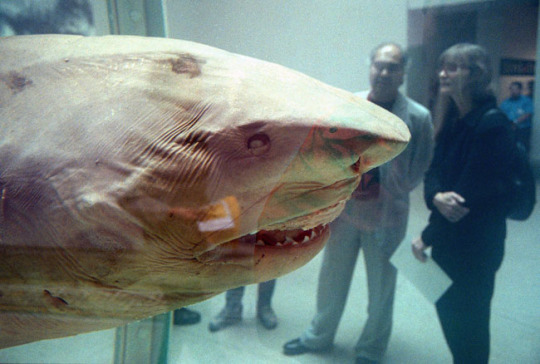
In the end, death as existentialist concept is perhaps something that can never be understood. I might always have questions about it. Luckily I have been exposed to Damien Hirst’s conceptual works, which inform me both of the fact that I don’t have to understand and that death is inevitable for me as a human. He does not depict death in violent ways that compel for us to be afraid, but instead as a very sterilized and perhaps spiritual event that is waiting for us. His most landmark works merely expose that no matter how much we attempt to hold onto life in the face of death, it will all come apart.
0 notes
Video
youtube
Superflat Monogram.
Murakami and Mamoru Hosoda collaborated to create an animated commercial to promote Louis Vuitton and Murakami to the Japanese consumer market. Superflat Monogram is notable because of its length and being a complete feature, and because it borrows heavily from Hosoda’s depiction of the void or of the virtual cyberspace found in his popular moves, with include Digimon (2000) and Summer Wars (2009).
2 notes
·
View notes
Text
Takashi Murakami

Takashi is one of the most prominent artists working now in the contemporary art scene. His work is very distinctive in terms of aesthetics and content, with Murakami commonly using a psychedelic-leaning color palette and infusing his work with strong elements of anime culture and Japanese history, with the fusion of his iteration of the new Japanese art with the old. “Hybridity” is actually an important component of Murakami’s identity as an artist, with him coining the term “Superflat” in 2001 to better describe his artistic ethos.

Superflat Manifesto, 2001, Murakami
Superflat as a theory and aesthetic takes key elements of old Japanese visual art, such as the flatness of 3D images on traditional paintings and infuses new images and motifs of neo-Japanese visual culture with it. An example of this is 727 (1996), a painting of Murakami’s alter ego Mr. DOB. Mr. DOB is moved by waves reminiscent of Hokusai’s ukiyo-e The Great Waves, remaining true to Murakami’s combining of the old and new of Japanese art. Superflat also corrodes boundaries between high and low art and culture, with the most “low” elements of the otaku subculture, such as adolescent boys and young men discovering and exploring their sexuality via anime, being depicted as true art. The most prime example is the infamous My Lonesome Cowboy (1998). Here, a young boy with spiked hair reminiscent of male characters in anime, is ejaculating. He stands powerfully and as if he has invoked something immense. Perhaps. In terms of looks, My Lonesome Cowboy follows the aesthetics of a PVC anime figure. However, he is stood on a podium like a traditional sculpture and is shown in museums instead of in stores.

727, 1996, Murakami, Owned by the Moma.

My Lonesome Cowboy, 1998, Murakami, Sotheby’s Auction
A strong element of Murakami’s ethos and of the Superflat theory is the blurring of boundaries between the fine arts and commercial arts, such as popular music and fashion. Murakami famously collaborated with Marc Jacobs in 2002 to design graphics for accessories (principally $900 handbags) for the Louis Vuitton fashion house. He placed his characters onto the bags. He also designed the iconic multichrome LV monogram. Clearly, Murakami is not hesitant in both criticizing and leveraging consumerism in his practice, with his collaboration with Louis Vuitton being of course very commercialist. He collaborated with Mamoru Hosoda (of Summer Wars) to produce two commercials, the more popular being titled Superflat Monogram (2003), to promote this new era of Louis Vuitton and the results of this creative copulation to Japan. Again, another blurring of lines. Not just did he bring elements of anime culture into his art, but he made his art (and his foray into fashion design) into an anime of its own. The commercial was complete with a storyline of a girl venturing through a Murakami-esque universe to retrieve her phone after it and she are swallowed by one of Murakami’s characters standing outside of a Louis Vuitton store. It’s hard to discern if this is a cautionary tale of a consumer getting lost in the void of consumerism, or if it is perhaps just an ambiguous depiction of an impromptu adventure the young girl goes on to enjoy as she finally retrieves her phone.

Louis Vuitton x Murakami (2002-2015)

Superflat Monogram (2003), Murasaki and Hosoda, Commercial
These works reflect Murakami’s desire to defeat barriers. They also further reflect his experiences as a Japanese male growing up in post-WWII Japan. He was an otaku who sought refuge through anime and science fiction, and this a strong reason as to why so many otaku themes are apart of his work. He was also apart of the era of Japan where character icons like Doraemon and Hello Kitty were being born. This culture, and Mickey Mouse due to his ears, are likely inspirations for Mr. DOB’s design.
Takashi Murakami is a notable contemporary artist because of his ease in blurring genres of art, design, and commercialism, and because of his ability to bring niche elements of various cultures to the forefront of the art world. He uses traditional Japanese paintings, figurine sculptures, luxury handbags, animation, and more, as mediums for his artistic exploration. Currently, he is in the process of working with Virgil Abloh of Off-White and many other design brands like Louis Vuitton and Evian Water. It’s likely that this partnership will create more landmarks works of this artist.
4 notes
·
View notes